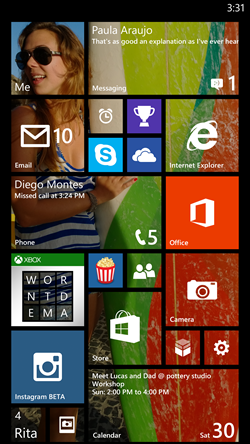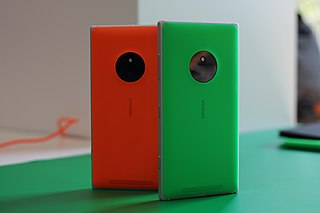
MSN is a web portal and related collection of Internet services and apps for Windows and mobile devices, provided by Microsoft and launched on August 24, 1995, alongside the release of Windows 95.

A barcode reader or barcode scanner is an optical scanner that can read printed barcodes, decode the data contained in the barcode to a computer. Like a flatbed scanner, it consists of a light source, a lens and a light sensor for translating optical impulses into electrical signals. Additionally, nearly all barcode readers contain decoder circuitry that can analyse the barcode's image data provided by the sensor and send the barcode's content to the scanner's output port.

Bing for mobile is a search tool for handheld mobile devices from Microsoft as part of their Bing search engine. It is designed for mobile device displays. Bing Mobile is built into Windows Mobile and Windows Phone as proprietary software, accessed via the Search key on Windows Phone 7 and Windows Phone 8 devices. It is also available on Windows Phone 8.1, and can be downloaded for other platforms, including and Android.
Microsoft engineering groups are the operating divisions of Microsoft. Starting in April 2002, Microsoft organised itself into seven groups, each an independent financial entity. In September 2005, Microsoft announced a reorganization of its then seven groups into three. In July 2013, Microsoft announced another reorganization into five engineering groups and six corporate affairs groups. A year later, in June 2015, Microsoft reformed into three engineering groups. In September 2016, a new group was created to focus on artificial intelligence and research. On March 29, 2018, a new structure merged all of these into three.
Mobile tagging is the process of providing data read from tags for display on mobile devices, commonly encoded in a two-dimensional barcode, using the camera of a camera phone as the reader device. The contents of the tag code is usually a URL for information addressed and accessible through Internet.

Windows Phone (WP) is a discontinued family of mobile operating systems developed by Microsoft for smartphones as the replacement successor to Windows Mobile and Zune. Windows Phone featured a new user interface derived from the Metro design language. Unlike Windows Mobile, it was primarily aimed at the consumer market rather than the enterprise market.

Windows Phone 8 is the second generation of the Windows Phone mobile operating system from Microsoft. It was released on October 29, 2012, and, like its predecessor, it features a flat user interface based on the Metro design language. It was succeeded by Windows Phone 8.1, which was unveiled on April 2, 2014.
Microsoft mobile services are a set of proprietary mobile services created specifically for mobile devices, they are typically offered through mobile applications and mobile browser for Windows Phone platforms, BREW, and Java. Microsoft's mobile services are typically connected with a Microsoft account and often come preinstalled on Microsoft's own mobile operating systems while they are offered via various means for other platforms. Microsoft started to develop for mobile computing platforms with the launch of Windows CE in 1996 and later added Microsoft's Pocket Office suite to their Handheld PC line of PDAs in April 2000. From December 2014 to June 2015, Microsoft made a number of corporate acquisitions, buying several of the top applications listed in Google Play and the App Store including Acompli, Sunrise Calendar, Datazen, Wunderlist, Echo Notification Lockscreen, and MileIQ.

Windows Phone 7 is the first release of the Windows Phone mobile client operating system, released worldwide on October 21, 2010, and in the United States on November 8, 2010. It runs on the Windows CE 6.0 kernel.
The Nokia Lumia 810 is a Windows Phone smartphone made by Nokia exclusively for wireless carrier T-Mobile US. It was announced on October 8, 2012. The device runs the then-new Windows Phone 8 operating system and features a 4.3-inch AMOLED WVGA ClearBlack display, an 8-megapixel rear-facing camera, a 1.5 GHz Snapdragon processor, exchangeable shells and supports Qi inductive charging when equipped with a specific shell. It supports T-Mobile's 4G network.

Lumia imaging apps are imaging applications by Microsoft Mobile and formerly by Nokia for Lumia devices built on the technology of Scalado. The Lumia imaging applications were notably all branded with "Nokia" in front of their names, but after Microsoft acquired Nokia's devices and services business the Nokia branding was superseded with "Lumia", and often updates included nothing but name changes, but for the Lumia Camera this included a new wide range of feature additions. Most of the imaging applications are developed by the Microsoft Lund division. As part of the release of Windows 10 Mobile and the integration of Lumia imaging features into the Windows Camera and Microsoft Photos applications some of these applications stopped working in October 2015.

Windows 8.1 is a release of the Windows NT operating system developed by Microsoft. It was released to manufacturing on August 27, 2013, and broadly released for retail sale on October 17, 2013, about a year after the retail release of its predecessor, and succeeded by Windows 10 on July 29, 2015. Windows 8.1 was made available for download via MSDN and Technet and available as a free upgrade for retail copies of Windows 8 and Windows RT users via the Windows Store. A server version, Windows Server 2012 R2, was released on October 18, 2013.

Bing Audio is a music recognition application created by Microsoft which is installed on Windows Phones running version 7.5 and above, including Windows Phone 8. On Windows Phone 8.1, and in regions where the Microsoft Cortana voice assistant is available, Bing Music is integrated with Cortana and the music search history is a part of Cortana's "Notebook". The service is only designed to recognize recorded songs, not live performances or humming. Xbox Music Pass subscribers can immediately add the songs to their playlists. A unique feature compared to similar services is that Bing Audio continuously listens and analyzes music while most other services can only listen for a fixed amount of time. Bing Research developed a fingerprinting algorithm to identify songs.

Windows Phone 8.1 is the third generation of Microsoft's Windows Phone mobile operating system, succeeding Windows Phone 8. Rolled out at Microsoft's Build Conference in San Francisco, California, on April 2, 2014, it was released in final form to Windows Phone developers on April 14, 2014 and reached general availability on August 4, 2014. All Windows Phones running Windows Phone 8 can be upgraded to Windows Phone 8.1, with release dependent on carrier rollout dates.

Cortana is a discontinued virtual assistant developed by Microsoft, that uses the Bing search engine to perform tasks such as setting reminders and answering questions for the user.

The Nokia Lumia 830 is a smartphone developed by Microsoft Mobile and branded as "Nokia" that runs Microsoft's Windows Phone 8.1 operating system. It was announced on September 4, 2014 at Internationale Funkausstellung Berlin and released in October 2014. It is a successor to the 2012 Nokia Lumia 820 and marketed as an "affordable flagship".
Windows 10 introduced a number of new elements, including the option to use a touch-optimized interface or a traditional desktop interface similar to that of Windows 7 along with live tiles from Windows 8. However, unlike previous versions of Windows, where most, if not all, major features for that release were completed by its RTM, Windows 10 continues to receive major features and changes beyond its initial release to market. Microsoft describes Windows 10 as an "operating system as a service" that will receive ongoing updates to its features and functionality. This is supplemented with the ability for enterprise environments to receive non-critical updates at a slower pace, and to use long-term support milestones that will only receive critical updates, such as security patches, over their ten-year lifespan of support.

Phone Companion is a discontinued app advertising and file transfer utility included with Windows 10 and available for Windows 10 Mobile. It provided a partial list of Microsoft apps that are available on Android, and Windows 10 Mobile. In order to use the Phone Companion, users had to sign in with a Microsoft Account, which would sync installation progress across devices. It was replaced by the Phone Link app in the October 2018 Update, but can still be accessed on prior versions.

Google Lens is an image recognition technology developed by Google, designed to bring up relevant information related to objects it identifies using visual analysis based on a neural network. First announced during Google I/O 2017, it was first provided as a standalone app, later being integrated into Android's standard camera app.










